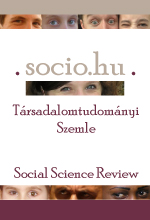A kontaktusalapú előítélet-csökkentés lehetőségei és korlátai
The Scope and Limits of Reducing Prejudice Based on Intergroup Contact
The Experiences of an Intervention
Author(s): Anna Kende, Nóra Anna LantosSubject(s): Social psychology and group interaction, Ethnic Minorities Studies, Social Norms / Social Control, Identity of Collectives
Published by: MTA TK Szociológiai Intézet
Keywords: intergroup contact; institutional norm; intergroup friendship; prejudice-reduction; anti-Roma prejudice
Summary/Abstract: Intergroup contact is the most effective method of prejudice reduction according to a vast number of studies conducted in various intergroup situations. However, it is not contact, but its optimal conditions which are difficult to attain in societies lacking a general acceptance of egalitarian social norms, facing strong segregation, large status differences, and endorsing strong prejudicial attitudes. Therefore, the optimal conditions for intergroup contact are rarely available when attempting to reduce prejudice against Roma people in Hungary. We present two studies in which we tested the influence of an intervention based on intergroup friendship – a highly positive example of intergroup contact – to reduce anti-Roma prejudice among university students. The research builds upon the so-called “fast friends” method which refers to a short closeness generating procedure based on mutual self-disclosure which creates an experience resembling real friendships. First year psychology students participated in our first study (N = 132) within an experimental, an extended contact, and a “control” group. We found some overall improvement in attitudes based on the comparison between the pre- and the post-test questionnaire results. In a second study (N = 61) we tested whether the findings of Study 1 were the direct result of the intervention, or its indirect influence through promoting non-prejudicial institutional norms. This time we worked with an experimental and a naïve control group, and found significant differences in attitude change between the groups along some attitudinal variables and in the perception of institutional norms. We discuss the scope and limits of anti-Roma prejudice reductions methods.
Journal: Socio.hu Társadalomtudományi Szemle
- Issue Year: 6/2016
- Issue No: 2
- Page Range: 38-60
- Page Count: 23
- Language: Hungarian

